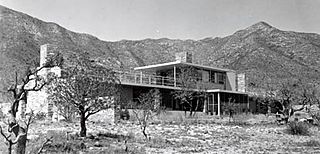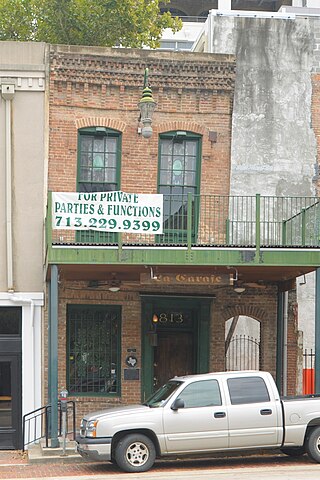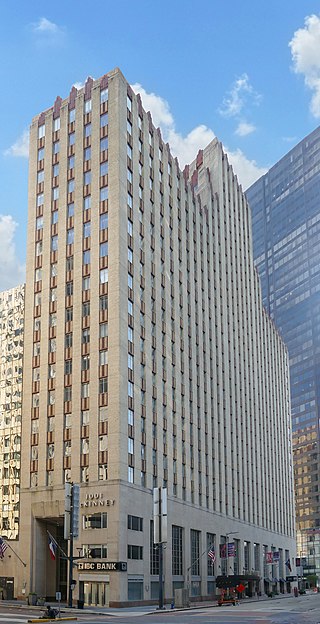
King Ranch is the largest ranch in the United States. At some 825,000 acres it is larger than the land area of Rhode Island and the European country Luxembourg. It is mainly a cattle ranch, but also produced the Triple Crown winning racehorse Assault.

The Texas School Book Depository, now known as the Dallas County Administration Building, is a seven-floor building facing Dealey Plaza in Dallas, Texas. The building was Lee Harvey Oswald's vantage point during the assassination of United States President John F. Kennedy on November 22, 1963. The Warren Commission concluded that Oswald, an employee at the depository, shot and mortally wounded President Kennedy from a sixth floor window on the building's southeastern corner; Kennedy died at Parkland Memorial Hospital.

The Magnolia Hotel is a 29-story, Beaux-Arts style, upscale hotel in the Main Street District of downtown Dallas, Texas, that for many years was the tallest building in the state after surpassing the Adolphus Hotel. The structure is a Dallas Landmark and is listed on the National Register of Historic Places.

San Antonio Missions National Historical Park is a National Historical Park and part of a UNESCO World Heritage Site preserving four of the five Spanish frontier missions in San Antonio, Texas, USA. These outposts were established by Catholic religious orders to spread Christianity among the local natives. These missions formed part of a colonization system that stretched across the Spanish Southwest in the 17th, 18th, and 19th centuries.

Thurber is an unincorporated community in Erath County, Texas, United States, located 75 miles west of Fort Worth. It was, between 1888 and 1921, one of the largest producers of bituminous coal in Texas and the largest company town in the state, with a population of over 10,000. The population of the community is 48 per the 2010 United States Census.
Los Ojuelos is a ghost town near Mirando City in the southeastern part of Webb County, Texas, United States. Before its establishment, Indians camped near the only dependable water source in the semiarid area. The local springs attracted Eugenio Gutiérrez in 1810 and attempted to settle in the area. Frequent Indian attacks forced Gutiérrez to abandon the site. in 1835, Eugenio's son returned to the site and tried to resettle the area but Indian attacks drove him back. In 1850, a company of Texas Rangers were stationed on the site to protect the trade route Laredo, Texas - Corpus Christi, Texas. In 1857, José María Guerra, grandson of Eugenio Gutiérrez and an ancestor of Laredo businessman Joe A. Guerra, built an irrigation system and a wall around Los Ojuelos to protect from Indian attacks.

Mosaic Dallas, formerly Fidelity Union Life Insurance Building, is a residential development in the City Center District of downtown Dallas, Texas, United States, adjacent to Thanks-giving Square. The complex is located at 300 North Akard Street, across the street from DART's Akard Station, which serves its Blue, Red and Green light rail lines.

This is a list of the National Register of Historic Places listings in Carlton County, Minnesota. It is intended to be a complete list of the properties and districts on the National Register of Historic Places in Carlton County, Minnesota, United States. The locations of National Register properties and districts for which the latitude and longitude coordinates are included below, may be seen in an online map.

Mission Nuestra Señora del Espíritu Santo de Zúñiga, also known as Aranama Mission or Mission La Bahía, was a Roman Catholic mission established by Spain in 1722 in the Viceroyalty of New Spain—to convert native Karankawa Indians to Christianity. Together with its nearby military fortress, Presidio La Bahía, the mission upheld Spanish territorial claims in the New World against encroachment from France. The third and final location near Goliad, Texas is maintained now as part of Goliad State Park and Historic Site

The Wallace E. Pratt House, also known as Ship on the Desert, was the residence of Wallace Pratt in what is now Guadalupe Mountains National Park in far western Texas. Pratt, a petroleum geologist for the Humble Oil & Refining Company, had previously built the Wallace Pratt Lodge in McKittrick Canyon a couple of miles to the north in the Guadalupe Mountains. Finding the cabin site to be remote and prone to being cut off by flooding, Pratt started construction of a new, modern residence on the east slope of the mountains. Work on the residence started in 1941. The house was designed by Long Island architect Newton Bevin, who lived for a time at the site with his wife, and built by contractor Ed Birdsall. Work was stopped by World War II, but resumed in 1945 and was completed the same year. In contrast to Pratt's rustic canyon cabin, the house, which Pratt named the Ship On The Desert, is an International Style house with horizontal lines and extensive glazing. Only 16 feet (4.9 m) wide and 110 feet (34 m) long, the house provides broad views to the east over the plains and the west to the mountains. The majority of the house is on a single level, with a "captain's bridge" over the dining room giving access to a rooftop terrace. A detached garage contained a guest bedroom. Apart from glass, the predominant material was local limestone in several shades.

Castolon, also known as La Harmonia Ranch and Campo Santa Helena, was a small community in southwestern Texas, located in what is now Big Bend National Park along the Rio Grande. The location was first settled in 1901 by Cipriano Hernandez, who farmed the area and built the original Castolon Store, now known as the Alvino House.

The Humble Oil Building, is a historic office building, designed in the Italian Renaissance architecture style, located at 1212 Main Street in Houston, Texas and listed on the National Register of Historic Places. It was constructed by Humble Oil and Refining Company in 1921. The tower section was added on to the building in 1936. The building complex served as the company headquarters for Humble Oil and Refining Company from 1921 until 1963, when the company moved into what is now the ExxonMobil Building at 800 Bell Street. In 2003, the building complex was renovated for use as a combination hotel and apartments, the apartment section was converted to additional hotel rooms in 2015.
The National Register Information System (NRIS) is a database of properties that have been listed on the United States National Register of Historic Places. The database includes more than 84,000 entries of historic sites that are currently listed on the National Register, that were previously listed and later removed, or that are pending listing. The database includes approximately 45 pieces of data for each listed property. Accuracy of the NRIS database may be imperfect. For example, a 2004 paper addressed accuracy of spatial location data for part of the NRIS content.

This is a list of the National Register of Historic Places listings in La Salle County, Texas.

Goliad State Park and Historic Site is a 188.3 acres (76 ha) state park located along the San Antonio River on the southern edge of Goliad, Texas. It was listed on the National Register of Historic Places (#01000258) on March 12, 2001.

Kennedy Bakery, located at 813 Congress Street in Houston, Texas, was listed on the National Register of Historic Places on July 27, 1979. The historic property in downtown Houston faces Market Square and lies within the Main Street Market Square Historic District. It is probably the "oldest Houston building existing on its original site."

The Texas Company Building, located at 1111 Rusk in Houston, Texas, was listed on the National Register of Historic Places on April 2, 2003.

The City National Bank Building, located at 1001 McKinney Avenue in Houston, Texas, was listed on the National Register of Historic Places on April 3, 2000.

The Midwest Oil Company Hotel, at 136 East 6th Street in Casper, Wyoming, is an historic hotel building which was listed on the National Register of Historic Places in 1983. It has also served as the Casper Women's Club House. Originally built by the Midwest Oil Company to accommodate workers during the Casper oil boom, it was taken over by Standard Oil Company of Indiana when that company bought Midwest Oil. In the 1930s, in the waning days of oil production in Natrona County, a local women's organization bought the hotel for $8,000 and was renamed the Casper Women's Club House.

















